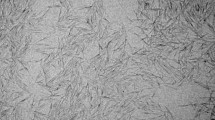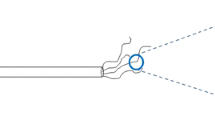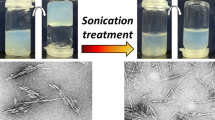Abstract
Cellulose nanocrystals (CNCs) with similar size and various surface charge densities were prepared by sulfuric acid hydrolysis and NaOH desulfation. The influence of surface charge density and NaCl concentration on the intrinsic viscosity of CNC suspensions and predicted aspect ratio were investigated by Ubbelohde viscometer. With decreased CNC surface charge density, the intrinsic viscosity initially decreased due to the electric double layers on the CNC surface and subsequently increased due to CNC aggregation. To screen electroviscous effect, NaCl was added into CNC suspensions. With increased NaCl concentration, the intrinsic viscosity of CNC suspensions first decreased and then increased. The aspect ratios of CNCs predicted by Batchelor equation from the minimum intrinsic viscosity were consistent with that measured by transmission electron microscopy. Suspensions of CNCs with higher surface charge density needed less NaCl to obtain minimum intrinsic viscosity. The NaCl content that should be added to the suspension to predict the actual physical aspect ratio of CNC can be estimated by Debye–Hückel theory, assuming that the Debye length is equal to the CNC diameter.





Similar content being viewed by others

References
Araki J, Wada M, Kuga S, Okano T (1998) Flow properties of microcrystalline cellulose suspension prepared by acid treatment of native cellulose. Colloid Surf A 142:75–82
Bagheriasl D, Carreau PJ, Riedl B, Dubois C, Hamad WY (2016) Shear rheology of polylactide (PLA)-cellulose nanocrystal (CNC) nanocomposites. Cellulose 23:1885–1897
Batchelor G (1970) Slender-body theory for particles of arbitrary cross-section in Stokes flow. J Fluid Mech 44:419–440
Bercea M, Navard P (2000) Shear dynamics of aqueous suspensions of cellulose whiskers. Macromolecules 33:6011–6016
Boluk Y, Lahiji R, Zhao L, McDermott MT (2011) Suspension viscosities and shape parameter of cellulose nanocrystals (CNC). Colloid Surf A 377:297–303
Capron I, Cathala B (2013) Surfactant-free high internal phase emulsions stabilized by cellulose nanocrystals. Biomacromol 14:291–296
Chau M et al (2015) Ion-mediated gelation of aqueous suspensions of cellulose nanocrystals. Biomacromol 16:2455–2462
Chen C, Yang C, Li S, Li D (2015) A three-dimensionally chitin nanofiber/carbon nanotube hydrogel network for foldable conductive paper. Carbohydr Polym 134:309–313
Csoka L, Hoeger IC, Rojas OJ, Peszlen I, Pawlak JJ, Peralta PN (2012) Piezoelectric effect of cellulose nanocrystals thin films. Acs Macro Lett 1:867–870
de Menezes AJ, Siqueira G, Curvelo AAS, Dufresne A (2009) Extrusion and characterization of functionalized cellulose whiskers reinforced polyethylene nanocomposites. Polymer 50:4552–4563
Domingues RMA, Gomes ME, Reis RL (2014) The potential of cellulose nanocrystals in tissue engineering strategies. Biomacromol 15:2327–2346
Dong XM, Revol JF, Gray DG (1998) Effect of microcrystallite preparation conditions on the formation of colloid crystals of cellulose. Cellulose 5:19–32
Dufresne A, Belgacem MN (2013) Cellulose-reinforced composites: from micro-to nanoscale. Polimeros-Ciencia E Tecnol 23:277–286
Eichhorn SJ (2011) Cellulose nanowhiskers: promising materials for advanced applications. Soft Matter 7:303–315
Emami Z, Meng QK, Pircheraghi G, Manas-Zloczower I (2015) Use of surfactants in cellulose nanowhisker/epoxy nanocomposites: effect on filler dispersion and system properties. Cellulose 22:3161–3176
Espino-Perez E, Bras J, Ducruet V, Guinault A, Dufresne A, Domenek S (2013) Influence of chemical surface modification of cellulose nanowhiskers on thermal, mechanical, and barrier properties of poly(lactide) based bionanocomposites. Eur Polym J 49:3144–3154
Favier V, Canova GR, Cavaille JY, Chanzy H, Dufresne A, Gauthier C (1995) Nanocomposite materials from latex and cellulose whiskers. Polym Adv Technol 6:351–355
Fedors RF (1974) A method for estimating both the solubility parameters and molar volumes of liquids. Supplement. Polym Eng Sci 14:472
Gong G, Mathew AP, Oksman K (2011) Strong aqueous gels of cellulose nanofibers and nanowhiskers isolated from softwood flour. Tappi J 10:7–14
Gray DG (2008) Transcrystallization of polypropylene at cellulose nanocrystal surfaces. Cellulose 15:297–301
Habibi Y (2014) Key advances in the chemical modification of nanocelluloses. Chem Soc Rev 43:1519–1542
Habibi Y, Lucia LA, Rojas OJ (2010) Cellulose nanocrystals: chemistry, self-assembly, and applications. Chem Rev 110:3479–3500
Hassanabadi HM, Alemdar A, Rodrigue D (2015) Polypropylene reinforced with nanocrystalline cellulose: coupling agent optimization. J Appl Polym Sci 132:42438
Heath L, Thielemans W (2010) Cellulose nanowhisker aerogels. Green Chem 12:1448–1453
Iwamoto S, Lee SH, Endo T (2013) Relationship between aspect ratio and suspension viscosity of wood cellulose nanofibers. Polym J 46:73–76
Jonoobi M, Oladi R, Davoudpour Y, Oksman K, Dufresne A, Hamzeh Y, Davoodi R (2015) Different preparation methods and properties of nanostructured cellulose from various natural resources and residues: a review. Cellulose 22:935–969
Jowkarderis L, van de Ven TGM (2014) Intrinsic viscosity of aqueous suspensions of cellulose nanofibrils. Cellulose 21:2511–2517
Kelly JA, Giese M, Shopsowitz KE, Hamad WY, MacLachlan MJ (2014) The development of chiral nematic mesoporous materials. Acc Chem Res 47:1088–1096
Klemm D, Kramer F, Moritz S, Lindstrom T, Ankerfors M, Gray D, Dorris A (2011) Nanocelluloses: a new family of nature-based materials. Angewandte Chemie-Int Edn 50:5438–5466
Larson RG (1998) The structure and rheology of complex fluid. Oxford University Press, New York
Li J, Revol JF, Marchessault RH (1996) Rheological properties of aqueous suspensions of chitin crystallites. J Colloid Interface Sci 183:365–373
Li MC, Wu Q, Song K, Lee S, Yan Q, Wu Y (2015) Cellulose nanoparticles: structure–morphology–rheology relationships. ACS Sustain Chem Eng 3:821–832
Lin N, Dufresne A (2014) Surface chemistry, morphological analysis and properties of cellulose nanocrystals with gradiented sulfation degrees. Nanoscale 6:5384–5393
Liu H, Liu D, Yao F, Wu Q (2010) Fabrication and properties of transparent polymethylmethacrylate/cellulose nanocrystals composites. Bioresour Technol 101:5685–5692
McKee JR, Hietala S, Seitsonen J, Laine J, Kontturi E, Ikkala O (2014) Thermoresponsive nanocellulose hydrogels with tunable mechanical properties. Acs Macro Lett 3:266–270
Mewis J, Wagner NJ (2012) Colloidal suspension rheology. Cambridge University Press, Cambridge
Mills P (1985) Non-Newtonian behaviour of flocculated suspensions. J Phys Lett 46:301–309
Moon RJ, Martini A, Nairn J, Simonsen J, Youngblood J (2011) Cellulose nanomaterials review: structure, properties and nanocomposites. Chem Soc Rev 40:3941–3994
Oksman K, Mathew AP, Bondeson D, Kvien I (2006) Manufacturing process of cellulose whiskers/polylactic acid nanocomposites. Compos Sci Technol 66:2776–2784
Parra-Vasquez ANG et al (2007) Simple length determination of single-walled carbon nanotubes by viscosity measurements in dilute suspensions. Macromolecules 40:4043–4047
Podsiadlo P et al (2007) Layer-by-layer assembled films of cellulose nanowires with antireflective properties. Langmuir 23:7901–7906
Rezaei A, Nasirpour A, Fathi M (2015) Application of cellulosic nanofibers in food science using electrospinning and its potential risk. Compreh Rev Food Sci Food Saf 14:269–284
Shafiei-Sabet S, Hamad WY, Hatzikiriakos SG (2012) Rheology of nanocrystalline cellulose aqueous suspensions. Langmuir 28:17124–17133
Shopsowitz KE, Qi H, Hamad WY, MacLachlan MJ (2010) Free-standing mesoporous silica films with tunable chiral nematic structures. Nature 468:U422–U426
Tang L, Weder C (2010) Cellulose whisker/epoxy resin nanocomposites. ACS Appl Mater Interfaces 2:1073–1080
Ubbelohde L (1937) Arrangement for testing the viscosity of liquid materials. US Pat 2091896 A
Wierenga AM, Philipse AP (1996) Low-shear viscosities of dilute dispersions of colloidal rodlike silica particles in cyclohexane. J Colloid Interface Sci 180:360–370
Wu Q, Henriksson M, Liu X, Berglund LA (2007) A high strength nanocomposite based on microcrystalline cellulose and polyurethane. Biomacromol 8:3687–3692
Wu Q, Meng Y, Concha K, Wang S, Li Y, Ma L, Fu S (2013) Influence of temperature and humidity on nano-mechanical properties of cellulose nanocrystal films made from switchgrass and cotton. Ind Crop Prod 48:28–35
Wu Q, Meng Y, Wang S, Li Y, Fu S, Ma L, Harper D (2014) Rheological behavior of cellulose nanocrystal suspension: influence of concentration and aspect ratio. J Appl Polym Sci 131:40525
Yang J, Han C-R XuF, R-C Sun (2014) Simple approach to reinforce hydrogels with cellulose nanocrystals. Nanoscale 6:5934–5943
Yang X, Shi K, Zhitomirsky I, Cranston ED (2015) Cellulose nanocrystal aerogels as universal 3D lightweight substrates for supercapacitor materials. Adv Mater 27:6104–6109
Yang J, Zhang E, Li X, Zhang Y, Qu J, Yu Z-Z (2016) Cellulose/graphene aerogel supported phase change composites with high thermal conductivity and good shape stability for thermal energy storage. Carbon 98:50–57
Zheng Q, Cai Z, Ma Z, Gong S (2015) Cellulose nanofibril/reduced graphene oxide/carbon nanotube hybrid aerogels for highly flexible and all-solid-state supercapacitors. ACS Appl Mater Interfaces 7:3263–3271
Acknowledgments
This work was financially supported by the Special Fund for Forest Scientific Research in the Public Welfare (201504603), Project of National Natural Science Foundation of China (21404092), Zhejiang Provincial Natural Science Foundation of China (No. LQ14C160004), Program for key Science and Technology Team of Zhejiang Province (2013TD17), and Tennessee Experimental Station Project #TEN00422.
Author information
Authors and Affiliations
Corresponding authors
Rights and permissions
About this article
Cite this article
Wu, Q., Li, X., Fu, S. et al. Estimation of aspect ratio of cellulose nanocrystals by viscosity measurement: influence of surface charge density and NaCl concentration. Cellulose 24, 3255–3264 (2017). https://doi.org/10.1007/s10570-017-1341-7
Received:
Accepted:
Published:
Issue Date:
DOI: https://doi.org/10.1007/s10570-017-1341-7



